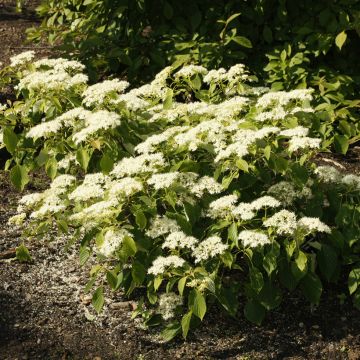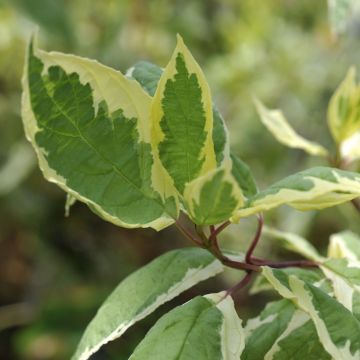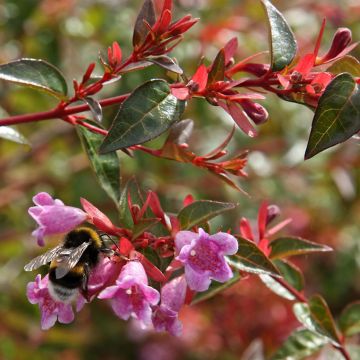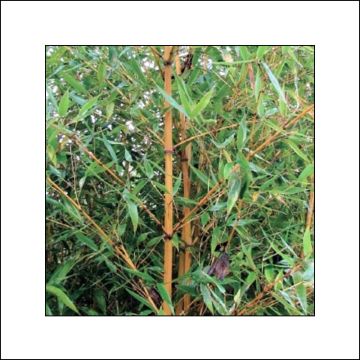

Cornus sanguinea Midwinter Fire - Common Dogwood


Cornus sanguinea Midwinter Fire - Common Dogwood


Cornus sanguinea Midwinter Fire - Common Dogwood


Cornus sanguinea Midwinter Fire - Common Dogwood


Cornus sanguinea Midwinter Fire - Common Dogwood
Cornus sanguinea Midwinter Fire - Common Dogwood
Cornus sanguinea Mid Winter Fire
Common Dogwood, Bloodtwig Dogwood, European Dogwood, Swida sanguinea
Lovely vigour at eight months: bright red stem, autumn foliage yellow sprinkled with pink. A pretty plant still in its youth, but well established.
jeff, 28/11/2025
Special offer!
Receive a €20 voucher for any order over €90 (excluding delivery costs, credit notes, and plastic-free options)!
1- Add your favorite plants to your cart.
2- Once you have reached €90, confirm your order (you can even choose the delivery date!).
3- As soon as your order is shipped, you will receive an email containing your voucher code, valid for 3 months (90 days).
Your voucher is unique and can only be used once, for any order with a minimum value of €20, excluding delivery costs.
Can be combined with other current offers, non-divisible and non-refundable.
Home or relay delivery (depending on size and destination)
Schedule delivery date,
and select date in basket
This plant carries a 24 months recovery warranty
More information
We guarantee the quality of our plants for a full growing cycle, and will replace at our expense any plant that fails to recover under normal climatic and planting conditions.

Would this plant suit my garden?
Set up your Plantfit profile →
Description
Cornus sanguinea 'Midwinter Fire' is a decorative variety of blood twig dogwood throughout the seasons. This bush has beautifully coloured wood in red-orange. Its leaves are tinted with gold in spring, becoming green in summer, then bright yellow in autumn. It also offers small bouquets of white flowers visited by pollinating insects in late spring. The red-stemmed dogwood and its varieties are sensational bushes that thrive in all types of soil and form remarkable borders in front of taller shrubs. Invite them into your garden!
Cornus sanguinea 'Midwinter Fire' was discovered in a garden in the Netherlands by H. Venhorst around 1988. Its wild ancestor, Cornus sanguinea, is a deciduous bush in the dogwood family. Native to a large part of Europe and eastern Asia, this plant has long attracted the attention of horticulturists who have selected varieties with young branches that are more colourful than those of the typical species.
Cornus sanguinea 'Midwinter Fire' has a bushy, tufted habit. It is taller than wide. At the age of 10, it will reach approximately 3m (10ft) in height and 2m (7ft) in spread, depending on growing conditions and if it is not regularly pruned close to the ground. When regularly pruned, it will not exceed 1.5 to 1.8m (5 to 6ft) in height. Pruning will encourage new branches to grow. These new branches are more colourful than the old stems. The almost fluorescent young branches are yellow-orange with red-orange tips. The foliage consists of entire, elliptical to ovate, slightly soft leaves with pointed ends. The foliage changes colour with the seasons. Flowering takes place in May-June. The tiny, lightly scented white flowers are gathered in flattened corymbs at the ends of the young shoots. After pollination by insects, they give way to clusters of small round berries that are first green, then red, and finally dark violet in summer. They delight birds who thus spread the seeds.
Cornus sanguinea 'Midwinter Fire' is truly undemanding in terms of soil type and exposure, making it as sturdy as it is decorative. It can be planted as a standalone in the centre of a perennial bed, in a mixed hedge, or to form large spectacular borders in front of taller shrubs. Its autumn colours blend beautifully with the flowering of asters, and its coloured wood enlivens the dark green or blue foliage of conifers in winter. It works well with climbing plants which will provide it with a lovely summer bloom, but will let it fully express itself in winter.
Report an error about the product description
Cornus sanguinea Midwinter Fire - Common Dogwood in pictures




Plant habit
Flowering
Foliage
Botanical data
Cornus
sanguinea
Mid Winter Fire
Cornaceae
Common Dogwood, Bloodtwig Dogwood, European Dogwood, Swida sanguinea
Cultivar or hybrid
Other Cornus
View all →Planting and care
Plant in spring or autumn, preferably in a sunny location, or in partial shade in hot climates. While this bush is relatively tolerant of shade, its growth will be significantly slowed in overly dense shade. It is not very demanding when it comes to soil type and can tolerate the presence of limestone, even in large quantities. Plant it in deep and well-drained soil to help it establish. Monitor watering during the first two or three years, especially during hot and dry weather. Its hardiness is excellent (at least -15°C (5°F)). Fertiliser inputs are not very useful for this plant, which can thrive in poor soils. However, a good base fertiliser placed at the bottom of the planting hole will help the bush start off well.
Planting period
Intended location
Care
-
, onOrder confirmed
Reply from on Promesse de fleurs
Similar products
Haven't found what you were looking for?
Hardiness is the lowest winter temperature a plant can endure without suffering serious damage or even dying. However, hardiness is affected by location (a sheltered area, such as a patio), protection (winter cover) and soil type (hardiness is improved by well-drained soil).

Photo Sharing Terms & Conditions
In order to encourage gardeners to interact and share their experiences, Promesse de fleurs offers various media enabling content to be uploaded onto its Site - in particular via the ‘Photo sharing’ module.
The User agrees to refrain from:
- Posting any content that is illegal, prejudicial, insulting, racist, inciteful to hatred, revisionist, contrary to public decency, that infringes on privacy or on the privacy rights of third parties, in particular the publicity rights of persons and goods, intellectual property rights, or the right to privacy.
- Submitting content on behalf of a third party;
- Impersonate the identity of a third party and/or publish any personal information about a third party;
In general, the User undertakes to refrain from any unethical behaviour.
All Content (in particular text, comments, files, images, photos, videos, creative works, etc.), which may be subject to property or intellectual property rights, image or other private rights, shall remain the property of the User, subject to the limited rights granted by the terms of the licence granted by Promesse de fleurs as stated below. Users are at liberty to publish or not to publish such Content on the Site, notably via the ‘Photo Sharing’ facility, and accept that this Content shall be made public and freely accessible, notably on the Internet.
Users further acknowledge, undertake to have ,and guarantee that they hold all necessary rights and permissions to publish such material on the Site, in particular with regard to the legislation in force pertaining to any privacy, property, intellectual property, image, or contractual rights, or rights of any other nature. By publishing such Content on the Site, Users acknowledge accepting full liability as publishers of the Content within the meaning of the law, and grant Promesse de fleurs, free of charge, an inclusive, worldwide licence for the said Content for the entire duration of its publication, including all reproduction, representation, up/downloading, displaying, performing, transmission, and storage rights.
Users also grant permission for their name to be linked to the Content and accept that this link may not always be made available.
By engaging in posting material, Users consent to their Content becoming automatically accessible on the Internet, in particular on other sites and/or blogs and/or web pages of the Promesse de fleurs site, including in particular social pages and the Promesse de fleurs catalogue.
Users may secure the removal of entrusted content free of charge by issuing a simple request via our contact form.
The flowering period indicated on our website applies to countries and regions located in USDA zone 8 (France, the United Kingdom, Ireland, the Netherlands, etc.)
It will vary according to where you live:
- In zones 9 to 10 (Italy, Spain, Greece, etc.), flowering will occur about 2 to 4 weeks earlier.
- In zones 6 to 7 (Germany, Poland, Slovenia, and lower mountainous regions), flowering will be delayed by 2 to 3 weeks.
- In zone 5 (Central Europe, Scandinavia), blooming will be delayed by 3 to 5 weeks.
In temperate climates, pruning of spring-flowering shrubs (forsythia, spireas, etc.) should be done just after flowering.
Pruning of summer-flowering shrubs (Indian Lilac, Perovskia, etc.) can be done in winter or spring.
In cold regions as well as with frost-sensitive plants, avoid pruning too early when severe frosts may still occur.
The planting period indicated on our website applies to countries and regions located in USDA zone 8 (France, United Kingdom, Ireland, Netherlands).
It will vary according to where you live:
- In Mediterranean zones (Marseille, Madrid, Milan, etc.), autumn and winter are the best planting periods.
- In continental zones (Strasbourg, Munich, Vienna, etc.), delay planting by 2 to 3 weeks in spring and bring it forward by 2 to 4 weeks in autumn.
- In mountainous regions (the Alps, Pyrenees, Carpathians, etc.), it is best to plant in late spring (May-June) or late summer (August-September).
The harvesting period indicated on our website applies to countries and regions in USDA zone 8 (France, England, Ireland, the Netherlands).
In colder areas (Scandinavia, Poland, Austria...) fruit and vegetable harvests are likely to be delayed by 3-4 weeks.
In warmer areas (Italy, Spain, Greece, etc.), harvesting will probably take place earlier, depending on weather conditions.
The sowing periods indicated on our website apply to countries and regions within USDA Zone 8 (France, UK, Ireland, Netherlands).
In colder areas (Scandinavia, Poland, Austria...), delay any outdoor sowing by 3-4 weeks, or sow under glass.
In warmer climes (Italy, Spain, Greece, etc.), bring outdoor sowing forward by a few weeks.


















































